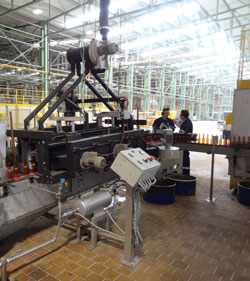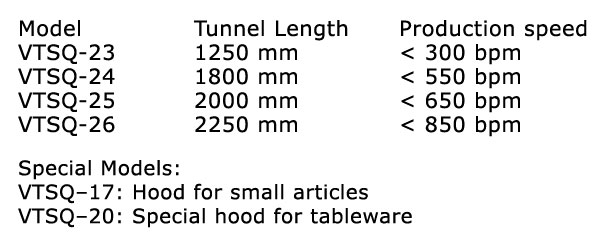When it comes to enhancing the durability and aesthetic appeal of glass containers, Vidromecanica has devised two innovative systems, namely hot-end coating and cold-end coating. These now play a pivotal role in surface treatment – addressing the specific requirements of glass bottles, flasks and plates. Both are strategically-applied before and after essential thermal treatment, which is designed to eliminate internal glass tensions – a process known as annealing.
Advantages of hot-end coating
For glass containers, the hot-end coating process offers the following key benefits:
- Increased internal pressure: It enhances the internal pressure of the bottle, thereby contributing to its structural integrity;
- Reduced risk of rupture: Glass containers become less susceptible to rupturing, ensuring product safety;
- Improved abrasion resistance: The coating significantly bolsters the resistance of the glass to abrasion, thus reducing wear and tear;
- Enhanced aesthetic appearance: Given that articles are rendered more attractive, the treatment process itself enhances the visual appeal of glass.
Hot-end coating hoods
 Vidromecanica boasts over three decades of expertise in manufacturing hot-end coating hoods. Traditionally, hot-end coating was performed using smaller hoods, i.e. typically less than a metre in length, with limited consideration for the environmental impact and product contamination. However, evolving environmental concerns and a growing need for equipment enhancements have prompted extensive research, jointly with efforts in development to address such weaknesses.
Vidromecanica boasts over three decades of expertise in manufacturing hot-end coating hoods. Traditionally, hot-end coating was performed using smaller hoods, i.e. typically less than a metre in length, with limited consideration for the environmental impact and product contamination. However, evolving environmental concerns and a growing need for equipment enhancements have prompted extensive research, jointly with efforts in development to address such weaknesses.
Determining the capacity of hot-end coating equipment necessitates careful evaluation of key factors – including the type and quantity of articles passing through the hood coupled with product concentration therein as well as the time each article passes in tunnel treatment. Achieving a delicate balance between hood length, product concentration and treatment duration is vital to maximising coating efficiency – essentially minimising product consumption while keeping environmental contamination within acceptable limits.
Here Vidromecanica’s hot-end coating hoods are engineered to ensure uniform distribution as well as high-quality surface treatment of both bottles and containers. Achieving effective adhesion of the subsequent cold-end coating largely depends upon the achievement of a consistent hot-end coating.
Standard Vidromecanica production includes the following models (ever mindful that customised hoods may also be developed upon request):
Based upon hood dimensions, product deposition is meticulously managed, employing laminar single-flow, double-flow or triple-flow systems. The choice of deposition system is determined by application and production rate, with options for adjustable product spraying concentration and one, two or three recirculation loops. The equipment also provides precise air circulation speed regulation.
Daining ratings have been incorporated into the construction to prevent environmental leakage of the product – adjusting product concentration such that it be higher at the central part and lower near the entry and exit doors – depending upon article diameter.
Notably, the geometry of the new convergent/divergent interior duct ensures better temperature control, distribution and uniformity of the coating film across the entire bottle diameter.
Here, Vidromecanica equipment is offered in either mild steel or stainless steel – featuring a modular design for adaptability to different glassware dimensions. To date the company is very satisfied with its performance on this score, owing to an impressive coating thickness levels of 35 CTU (Coating Thickness Units) in the bottle’s body, coupled with a deviation of just 5 CTU. Not only. The equipment is efficiently-managed by an HMI+PLC system with online communication to a PC, which provides precise control over temperature, product weight, product flow and article flow.
Added optional features:
- Optimal temperature regulating devices
– Heating with resistances
– Cooling of the equipment by fans - Dosing Pump Control with IR-Sensor
- Digital weighing system and drum stand
- System for elevating / descending the equipment
– Model type 1 – Portic next to the conveyor
– Model type 2 – Cables above the hood
– Model type 3 – Underneath the conveyor - Hood prepared to receive SEPOAN
- Lifting System by opening side door
- PLC + HMI touchscreen panel
 Standardised Processes
Standardised Processes
Boasting a wealth of experience spanning over 30 years in the industry, Vidromecanica’s expertise is rooted in dedicated research and development. The company’s relentless pursuit of excellence has led to the design and testing of a wide range of technical solutions in order to meet unique customer requirements. Machinery is typically built to deliver peak performance and can operate around the clock – making it a reliable and efficient choice for glass production plants worldwide.
In sum, Vidromecanica’s hot-end coating offers a cutting-edge solution for the protection and enhancement of glass containers. Whether customers be focused on improving durability, upon aesthetics or on glass product safety, the company’s state-of-the-art equipment and standardised processes are nonetheless equally designed to meet specific needs – all to ensure that glassware maintains its appeal and quality.





